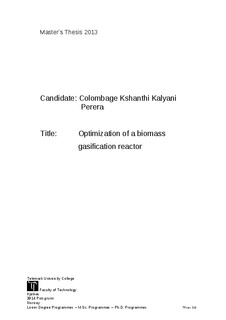| dc.description.abstract | Steam gasification is a well-known technology which is used to produce a high quality product gas, especially for power generation applications. The gas composition, gas quality and the purity are important for the end application. The biomass steam gasification was studied using the Computational Particle Fluid Dynamics (CPFD) simulation tool, "Barracuda VR (TM). The software is well suited for simulating the dense particle laden fluids due to its numerical solving methods for both the particles and the fluid. Both the experiments and simulations were carried out for a cylindrical isothermal fluidized bed without chemistry, to compare the deviations of simulation results from the experimental results. The simulation results agreed well with experimental results and confirmed the same minimum fluidization velocity. Hence the model was used for further simulations. Three dimensional simulations were carried out for a cylindrical geometry to study the energy and momentum transport within a simplified dual fluidized bed steam gasification reactor. The important chemistry was included. Simulations were performed under seven cases to investigate the effect of bed material size, consistency of biomass supply, steam temperature, steam input velocity, addition of CO2 and the bio mass particle size on the rate of combustible gas production. According to the simulation results, the product gas was generated consistently over the time, except in one case. The product gas volume mainly consisted of ~ 40 % CO, ~ 15% H2, ~ 25% CH4 and ~20% CO2.The highest cumulative production of combustible gasses (CO, CH4 and H2) was rated by Case-G, which was estimated as 400 Sm3/day based on the simulation results. According to the results it was found that the reduction of bed material size and choosing the optimum particle size for biomass enable to enhance the gas production. The rate of gas production was adversely affected by the decrease of steam temperature. Increase of the steam input velocity and substitute of steam in the biomass feed with CO2 did not contribute for enhancing the product gas volume. | |
